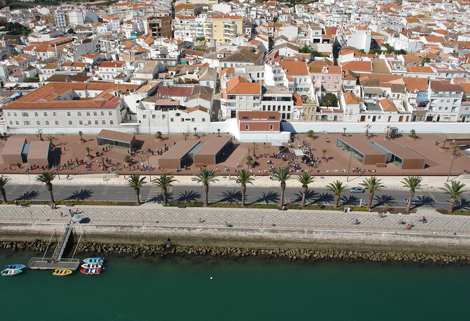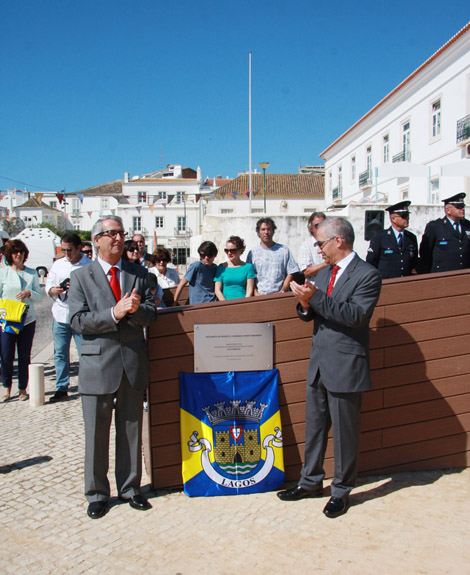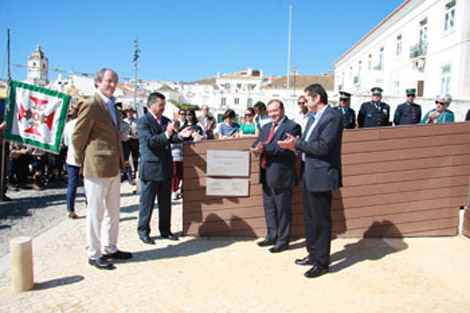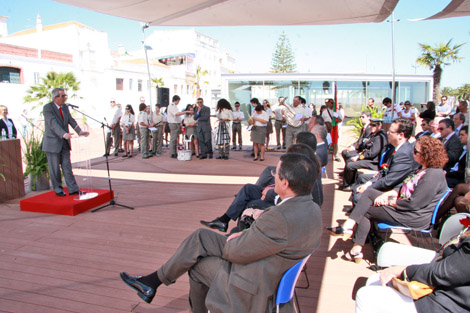 The Esplanada do Infante, considered as «a remarkable work for the rehabilitation of the Lagos Riverside Front», was inaugurated on April 25, as part of the official commemorations of the Carnation Revolution.
The Esplanada do Infante, considered as «a remarkable work for the rehabilitation of the Lagos Riverside Front», was inaugurated on April 25, as part of the official commemorations of the Carnation Revolution.
Designed by architect António Barbosa, from the A400 Architecture Office, the Rehabilitation of the Riverfront Front was the project that had the most impact in the city of Lagos, involving an intervention area of over 22 thousand square meters, translating into the largest investment of any kind. time held in the city.
The Esplanada do Infante, located on the roof of the Front Ribeirinha car park, intends, according to the Câmara de Lagos, «to assert itself as a leisure, leisure and cultural space, which will definitively mark the city's seafront».
It comprises three sets of pavilions that each include a bar and a space/equipment for exhibitions, with a terrace area, in addition to a fourth autonomous building for a sales/stationery station.
 For the architect responsible for the work, present at this ceremony, it is expected that the Esplanada do Infante will constitute “the new face of Lagos, and that it will be totally in tune with the new social rhythms of the city”.
For the architect responsible for the work, present at this ceremony, it is expected that the Esplanada do Infante will constitute “the new face of Lagos, and that it will be totally in tune with the new social rhythms of the city”.
António Barbosa referred that this is, in his opinion, “one of the best gateways to a historic city center”.
The main objectives of this intervention, integrated in the Polis project, were to revalue the city's historic landmarks (namely the old Cais da Ribeira and the wall next to the park) and to relate the surrounding maritime landscape with the urban fabric, in other words, “returning the riverfront and the relationship with the sea lost in the 50s”.
The architect once again stated that that intervention “aims to diversify the offer of new daily trends, mitigating the imbalances caused by seasonal tourism and strengthening the identity of the Riverside Front, as a center for aggregating local and seasonal populations”.
In conclusion, António Barbosa congratulated the local authority, “for having bet in advance on urban renewal and enhancement of its territory, and having the courage and determination to move forward with the completion of this work at this particularly difficult time in the country”, also taking advantage of the occasion to leave a word of thanks to Futurlagos, for having been “tireless” in following the work.
Before that, António Marreiros, deputy mayor and chairman of the Board of Directors of that municipal company, had highlighted, regarding the completion of this requalification work, that it was carried out within the budgeted amount of 1.314.500 euros, and that the price is fully paid, largely with funds resulting from various applications for urban rehabilitation programs and tourism incentives carried out by the company.
 Júlio Barroso, Mayor of Lagos, began his brief speech by recalling that “every year the Municipality makes a point of highlighting this date” which, in his opinion, brought one of the “greatest victories for the country” – the institutionalization of democratic power.
Júlio Barroso, Mayor of Lagos, began his brief speech by recalling that “every year the Municipality makes a point of highlighting this date” which, in his opinion, brought one of the “greatest victories for the country” – the institutionalization of democratic power.
Making sure that the concern of this municipal executive “has always been to give body and substance to the values of 25 April”, the mayor stressed that “it is not the crisis that devastates us and the austerity that they impose on us that will make us lower your arms”.
For Júlio Barroso, a work like this “represents a new stage in the city”, contributing decisively to making Lagos “a more modern and easily accessible city, without ever losing the historical traces that characterize it”.
The mayor believes that “the renovation of Lagos will facilitate the daily lives of its inhabitants and companies, will give those who visit us new conditions of comfort and convenience, contribute to a reinforcement of the image of tourist quality and consequent economic and social progress” .




















Comments